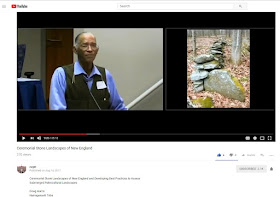“This is a serpent effigy - and the serpent effigies are quite often in dispute because the presumption is that they are stone walls. Most often, they are too low to pen anything in, but we identify them by other means. Usually they do have a head, such as the one you see here. This particular one, just behind the head, also has a space and an orange stone, because we believe that they are related to the serpent effigy that is in the area of Scorpius that the Cherokee referred to as the Uktena, that is, a serpent with an orange stone. In its terra form, it’s (it has) a jewel and it is horned, but this is, as below, so above...”
Doug Harris
Image lifted from: https://youtu.be/35hswwxcIFI?t=9m9s
The complete text and video
can be seen here at the National Park Service website:
This presentation was part of
the Proceedings of the Maritime Cultural Landscape Symposium, October 14-15,
2015, University of Wisconsin-Madison.
Note: DH is likening the Orange stone (as below/in the stone "wall") to the orange colored bright star Antares that is the Jewel on the head of the Great Serpent constellation (as above in the sky), part of what Europeans came to call Scorpius.
"Those who know say the
Uktena is a great snake, as large around as a tree trunk, with
horns on its head, and a bright blazing crest like a diamond
on its forehead, and scales glowing like sparks of fire. It has rings
or spots of color along its whole length, and can not be wounded except by
shooting in the seventh spot from the head, because under this spot are its
heart and its life. The blazing diamond is called
Ulun'suti—"Transparent"—and he who can win it may become the greatest
wonder worker of the tribe. But it is worth a man's life to attempt
it, for whoever is seen by the Uktena is so dazed by the
bright light that he runs toward the snake instead of trying to escape. As if
this were not enough, the breath of the Uktena is so
pestilential, that no living creature can survive should they inhale the
tiniest bit of the foul air expelled by the Uktena. Even to see the
Uktena asleep is death, not to the hunter himself, but to his family." -
James Mooney Myths of the Cherokee


The New England stone works apparently had many serpents--but more as an important part of their architectures than assigning them (i.e. every one of them), the constellation Scorpius! There has to be an entirely new perspective drawn regarding the functionality of the New England walls other than astronomical precept. Many of us are quite familiar with Moon ey's stories, and to be sure, they are important--very important. There was a greater underlying AND overarching truth to these artifacts, and it would behoove us to put the jewels down fror now until we understand them to be much more than star representations. Remember that the jewel at the head of the Uktena, the Ulun'suti, was NOT a star, it was a brilliant lamp to the wilderness that was part of the Great Medicine of long ago. Perhaps attributing ceratin stones to certain stars is a learner's plateau that we can take a little break on while we continue the climb to a glory that we mortals cannot even begin to comprehend (as yet)!
ReplyDelete